Abstract
Repeat and near-repeat victimization are important concepts in the study of crime. The incidence of repeat offenses within a single type of crime has been confirmed. However, the study of the circumstances existing across crime types requires further investigation. This article investigates whether the phenomenon of near-repeat crime exists in different types of crime by studying the spread of crime risk within different crime types. Taking Suzhou City as the research area, a DBSCAN-based algorithm is proposed, which can detect a large number of important and stable hotspots through the multi-density self-adaptation of algorithm parameters. Pearson correlation is used to analyze the risk correlation between different types of crime. In different crime hotspots, the types of crime and the spread of crime risk among different types is also different. After a crime occurs, identifying the risk can aid crime prevention.
1. Introduction
The increase in urban crime has seriously affected social development, and the development of a method with which to effectively reduce or suppress crime has long been the subject of research [1]. Crime is a form of behavior that occurs when people with criminal motives discover or create opportunities for the perpetration of illegal activity. Crime tends to follow the patterns of daily activities in urban environments. The general movement pattern of activity nodes (such as work or school places, main shopping areas, or residential buildings) provides places in which criminals can concentrate and victimize a large population [2]. When large numbers of people move through an area of activity, some of them take the opportunity to commit crimes. Some nodes of activity have special characteristics known as opportunities for crime, which can attract people with high levels of criminal motivation and a history of repeated criminal activity. Nodes of activity and crime spaces influence where occasional and long-term offenders commit crimes. For occasional offenders, crimes are committed when tempting opportunities are found in daily activities. For habitual offenders, searching for crime opportunities and committing crimes have become daily activities [3].
In the 1930s, Chicago Professors Robert Parker and Ernst Burgess proposed the concept of environmental criminology. In addition, in the 1980s, Clarke, Cohen, Felson, and Brantingham et al. provided a more specific explanation and study of environmental criminology, that is, the relationship between criminal phenomena and spatial and geographical factors, which can help reduce crime opportunities through the design and management of the surrounding environment [4,5,6]. According to environmental criminology, predatory robbery is easier and more frequent when potential offenders and appropriate targets gather at a certain time and in a certain place in the absence of a protector [7].
Environmental criminologists have formed many theories. Cohen and Felson put forward the “Routine activities theory” in 1979, which contends that the generation of criminal activities is closely related to the region of the daily activities of residents. The theory includes three factors: potential offenders with criminal motives, potential victims, and a lack of regulators. A potential offender with criminal motives and desirable potential victims may commit crimes in areas where there is no effective regulation [8]. The “Rational choice theory” was proposed by Clarke and Felson in 1986. This theory holds that rational choice is a decisive factor that determines whether an offender will commit a crime. Potential offenders judge the risks and benefits of crimes according to various factors and ultimately determine whether to commit a given crime [9].
The occurrence of crime is not randomly and uniformly distributed in space; it manifests with certain aggregational and discrete characteristics, i.e., crime hotspots. A crime hotspot is the main concept of crime geography [10]. In crime hotspots, not all families are victimized. Therefore, in order to optimize the efficiency of crime reduction efforts, it is necessary to more accurately understand the dimensions of crime risk. Research has shown that prior victimization is a good predictor of future risk, and once it occurs, repeated victimization often happens quickly. Repeat victimization may be a more common spatiotemporal pattern of victimization [11,12,13].
Many studies have confirmed the existence of recidivism and near-repeat crime and proposed the terms “flag” and “boost” to explain this criminal phenomenon [10,11,12,13,14]. A flag refers to the sharing of information or the sending of signals to other criminals to inform potential targets of criminal activities, such as potential victims or the location of valuable items. The purpose of marking is to provide advance notice and promote the coordination of criminal activities. For example, thieves may “mark” rich communities as potential targets by sharing information about the locations and habits of potential victims [15].
Boosting refers to the act of providing assistance to another criminal during a crime. Such assistance can take many forms, such as acting as a lookout, distracting potential witnesses, or helping to carry stolen goods. The purpose of boosting is to increase the chance of successfully executing a criminal action and reduce the risk of being discovered or captured. Repeated crime and near-repeat crime are crucial aspects of crime prevention. Information can be transferred to another crime within a certain period and distance, that is, the risk of crime can be communicated [15]. Bowers and Johnson’s research suggests that the risk of victimization is contagious. The initial victimization risk of burglary not only affects the burglarized property but also spreads to neighboring properties in a manner similar to the transmission of infectious diseases. Just like repeat victimization, the risk of burglary for nearby properties increases in the short term and then returns to the pre-incident level [16]. This spatiotemporal clustering pattern is called the “near repeat crime” phenomenon.
Crime risk can be spread through various channels. Criminals can use social media platforms to spread information about criminal activities, such as sharing videos or photos on social media after violent incidents or robberies occur. Traditional media such as television, newspapers, and radio can also spread information about criminal behavior, including details of a case, descriptions of suspects, and eyewitness testimonies. Criminals can spread information about criminal behavior through verbal communication, such as sharing criminal tools and techniques or providing others with experiences and knowledge on how to commit crimes. On illegal online marketplaces, criminals can sell and exchange criminal tools and information, such as fake IDs, bank card information, and passwords [17].
Research on near-repeat crime can be divided into repeat offenses within a single type of crime and repeat offenses between different types of crime. In the former, the phenomenon of repeat offenses occurring within a single type of crime has been confirmed [10,11,12,13,14,15,16,17,18], and the transfer of crime risk has also been confirmed to spread within the same type of crime. However, the study of the correlation between different types of crime requires further investigation. According to crime opportunity theory, crime is an act that is jointly affected by opportunity and motivation. If a criminal successfully commits a crime in one place, they may continue to look for similar opportunities to carry out other types of crime nearby [19]. Wang found a significant spatiotemporal correlation between the two crime types within a close range, with crime risk being propagated across crime types [20].
Crime risk can be spread among different types of crimes because many criminal acts have common characteristics. For example, a criminal may use similar tools and technologies to carry out different types of criminal acts, such as using wiretaps for monitoring, using violence for robbery, using fraud for defrauding, and so on. In addition, there may be a mutually reinforcing relationship between different types of crime; that is, some types of crime may provide opportunities or convenience for other types of crime. For example, pickpockets look for crowds, while other offenders are more concerned with the absence of crowds. The flow of workers returning home at night and on weekends produces a counter flow a few hours later of commercial and industrial burglars that take advantage of the situation [8].
The occurrence of near-repeat crime in a neighborhood also proves the stability of crime hotspots. The stability of crime hotspots refers to crimes that not only have certain aggregational characteristics in space but also remain stable in time with respect to the spatial aggregation of crimes [21,22,23]. Weisburd’s research on the city of Seattle proved the existence of hotspot stability and the effectiveness of police deployment according to crime hotspots. Criminal activities in micro-areas are highly stable over time [24,25,26]. Following Weisburd’s study on the stability of crime hotspots in different countries and regions, many scholars obtained similar experimental results using different methods, such as pooled observations, group-based trajectory modeling, and k-means clustering, with which they verified the stability of crime hotspots [27,28,29]. The spatiotemporal distribution of crime and its formation mechanisms are among the most important topics of crime geography research [30,31,32,33,34]. Research on the spatiotemporal distribution of crime can further reveal the spatial distribution characteristics and trends of urban crime in different regions and different types of crime on different time scales. It can also help us to understand the relationship between criminal activities and spatial environmental factors. After discovering crime hotspots, further examination of the relationship between crime and the spatial environment in which it occurs can help to prevent and deter crime through the alteration of an environment [35,36].
In light of the aforementioned issues, the objectives of the present study are to perform a correlation analysis of the different types of crime risk in a stable hotspot area and explore methods for decreasing crime risk by changing crime prevention tactics.
2. Study Area and Crime Data
Suzhou City is located in the southeast of Jiangsu Province and has the sixth highest GDP in China. It includes many types of areas, such as residential areas, business districts, business centers, high-tech development zones, and so on. We selected four districts of Suzhou, namely, Huqiu District, Gusu District, Wuzhong District, and Xiangcheng District. The number of crimes committed in these four regions amounts to 80% of the whole city, for which hotspots were generated in the data-preprocessing stage, while there were no hotspots generated in other regions. Thus, we selected these four districts and eliminated any water-covered area to create our study area. Figure 1 shows the kernel density estimation of crime data in the study area from December 2011 to October 2013.
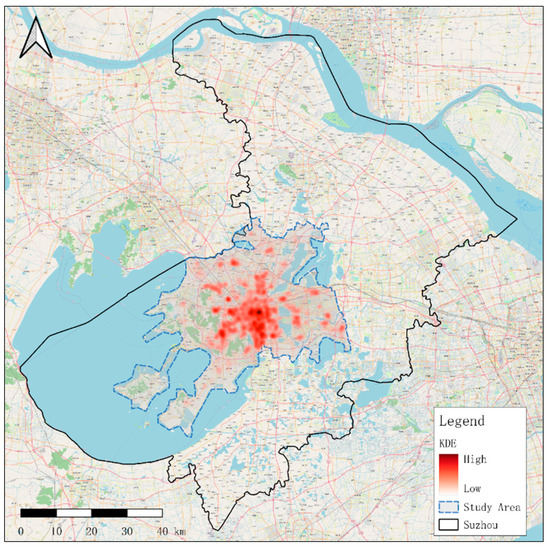
Figure 1.
Kernel density map for criminal cases in the study area.
In this paper, we selected 10 typical crime types (pickpocketing, theft of vehicular property, office creeper activity, vehicle theft, shoplifting, telecom fraud, robbery, home burglary, internet fraud, and delict). Table 1 shows the description and number of cases of crime types. The number of cases of different crime types that occurred each week was integrated, and these weekly data were used as research data.

Table 1.
Description and quantity of crime types.
3. Hotspot Extraction
A crime hotspot is generally defined as an area containing dense clusters of criminal incidents. Therefore, clustering algorithms can be used to extract stable areas where crime is concentrated. Density-based clustering algorithms use density as the clustering criterion and can find clusters of any shape without presetting the number of clustering results. A representative algorithm is DBSCAN (Density-Based Spatial Clustering of Applications with Noise), which can filter out abnormal points as noise while clustering.
To solve the problem wherein the traditional DBSCAN algorithm requires the Eps and Minpts parameters to be manually set, the KMNN-DBSCAN (K-means nearest neighbor DBSCAN) algorithm is proposed. This algorithm uses the dataset’s own distribution characteristics to generate a list of Eps and Minpts parameters and then determines the optimal Eps (Epsilon) and Minpts (Minimum Points) via an optimization strategy to achieve the complete self-adaptation of the two parameters [37]. Eps specifies how close the points should be to be considered part of a cluster. This means that if the distance between two points is lower than or equal to this value (eps), these points are neighbors. In the data-preprocessing stage, Euclidean distance or Manhattan distance was calculated; it was found that there was no impact on the results. So, Euclidean distance was used to calculate the distance between two points. Minpts represents the minimum number of points required to form a dense region. For example, if we set the Minpts parameter to 5, then we need at least five points to form a dense region.
The accuracy of experimental results is directly affected by the experimental parameters. The traditional DBSCAN algorithm can produce errors when clustering datasets with large density differences. Therefore, to determine the experimental parameters, the K-means nearest neighbor method based on the self-decay term was used to generate the optimal value of Eps, and the mathematical expectation method based on the self-decay term was used to generate the optimal value of Minpts, while five was assigned as the number of continuous and stable clusters for use as the parameter with which to determine the stability interval [38]. The steps of the DBSCAN algorithm are included in the Supplementary Materials (Algorithm S1: DBSCAN algorithm).
Most of the studies on crime hotspots employ the geographical locations of criminal cases to analyze crime hotspots using a clustering algorithm. However, research on the change in crime types in a given interval in a time series requires the analysis of crime data based on time series. Therefore, the quadratic DBSCAN algorithm in this paper was used to calculate the crime hotspots, for which one week was used as the time interval. To obtain stable hotspots, we employed the following procedure: (1) Based on the weekly data of various types of police intervention, the weekly data were obtained using the K-average nearest neighbor method based on the self-decay term to obtain the weekly Eps and Minpts list. (2) Clustering was performed on the weekly dataset to obtain the stable cluster class and the geometric center of each cluster. (3) The geometric center obtained in the previous step was optimized again to obtain the optimal values of Eps and Minpts. (4) Following clustering to obtain the cluster, five stable clusters were considered to comprise one hotspot. According to the results of the DBSCAN algorithm for clustering detection, Figure 2 shows the nine stable hotspot regions that we obtained.
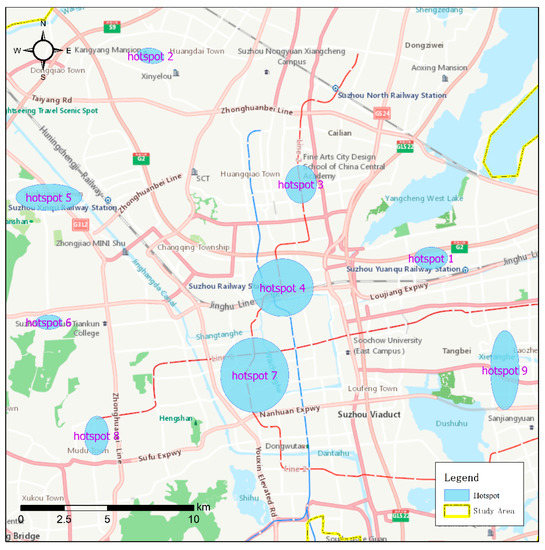
Figure 2.
Hotspot thumbnail.
The crime hotspots were relatively concentrated, mainly in central urban areas, but hot spot analysis suggested a need for deeper analysis within micro-locations [39]. The micro-sites in each hot spot are shown in Table 2.

Table 2.
Hotspots’ geographic locations.
4. Crime Risk Interaction Analysis
After identifying the stable hotspots, we analyzed the correlation among crime types within a crime hotspot area to determine the interactions of crime risk. Then, we analyzed the correlation and differentiation of each pair of crime types for different land use types. To determine the correlations between crime types, we employed the Pearson correlation coefficient, which is used to express the closeness of the relationship between two variables [40]. The larger the absolute value of the correlation coefficient, the stronger the correlation coefficient; further, the closer the correlation coefficient is to 1 or −1, the stronger the correlation coefficient is, while the closer the correlation coefficient is to 0, the weaker the correlation coefficient is. The absolute values can be categorized as 0.8–1.0 (an extremely strong correlation), 0.6–0.8 (a strong correlation), 0.4–0.6 (a moderate correlation), 0.2–0.4 (a weak correlation), and 0.0–0.2 (an extremely weak correlation/no correlation).
Assuming that there are two variables, X and Y, the calculation formula for the Pearson correlation coefficient between the two variables is as follows:
Based on the multiple hotspots obtained in the previous step, we obtained the correlations between the types of crime in the hotspot areas. The research showed that the risk of a repeated crime is highest within a week after a certain type of crime has occurred [20]. Therefore, this article adopts a one-week period to analyze the spread of crime risk.
Within the same crime hotspot area, we analyzed the correlation between the total number of crime type 1 cases in a given week and the number of cases of another crime type in the following week to obtain a data list (examples are shown in Table 3); then, we calculated the correlation coefficient between pairs of crime types in each hotspot area.

Table 3.
Crime type correlations.
Figure 3 shows the correlation coefficient of each crime type in every crime hotspot area and the proportion of each crime type in each hotspot area. Figure 3a show the correlations between crime types. The abscissas in the graphs indicate crime type 1, while the ordinates indicate crime type 2. The Figure 3b show the distribution of the number of crime types in the hotspot areas identified.
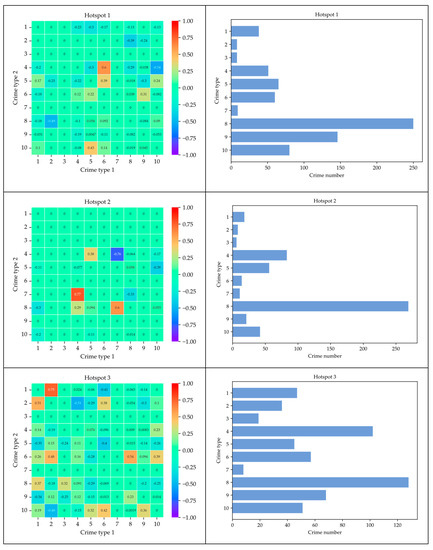
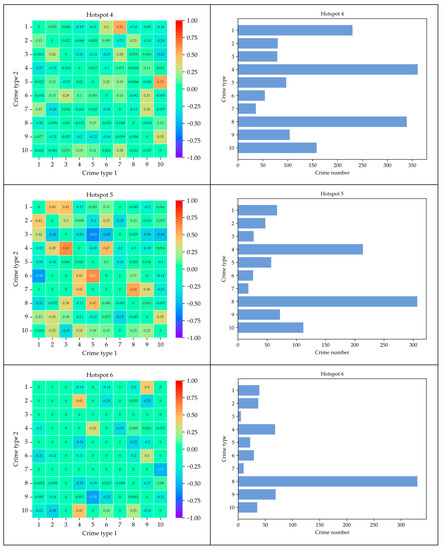
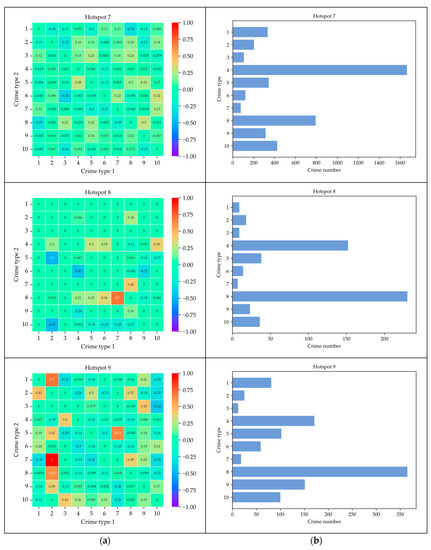
Figure 3.
(a) Correlation coefficients of crime types in hotspot areas. (b) Number of cases of a given crime type in each hotspot area. (Note: different digital identifiers on the axes represent different crime types, as follows: (1) pickpocketing, (2) vehicle property theft, (3) office creeper activity, (4) vehicle theft, (5) shoplifting, (6) telecom fraud, (7) robbery, (8) home burglary, (9) internet fraud, and (10) delict.)
Figure 4 and Table 4 show the data with significant, strong correlations according to the Pearson correlation coefficient, i.e., the main research object of this study.
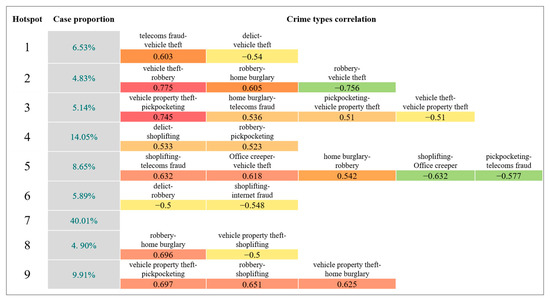
Figure 4.
Strong correlation coefficients of crime types.

Table 4.
Strong correlation coefficients of crime types.
5. Discussion
Based on the criminal cases in Suzhou occurring from December 2011 to October 2013, this study extracted stable crime hotspots. According to the spatial distribution of the crime hotspots, there were relatively large differences in the main urban areas, areas with complete public facilities, and areas with underdeveloped economies, as suggested by many previous studies [41]. More crime opportunities are generally created in the main urban areas, which are characterized by more malls, crowds, and more possible crime types, such as pickpocketing, home burglary, and shoplifting [18]. For example, Gusu District, the main urban area of Suzhou City, was found to have the two largest crime hotspots: hotspot 4 and hotspot 7. In hotspot areas with high crime rates, the correlations between crime types were not strong, indicating that each crime type was relatively independent. The offenders committing different crime types in these hotspot areas were generally found to have individual targets. When there are more opportunities for crime, according to “Rational choice theory”, offenders are inclined to use the modus operandi with which they are adept.
According to the correlations between the different types of crime, we found the following interactions between different types of crime:
- (1)
- There was a strong, positive correlation between vehicle property theft and home burglary. In many small areas, motor vehicle theft and home burglary had a strong correlation, such as that found for hotspot 9, which was likely because neighborhoods with a high concentration of residents may have a higher concentration of vehicles. For criminals to commit burglary or steal vehicles, potential targets must be marked in advance. Thieves share information about potential victims’ locations and habits and may provide this information to other criminals to carry out other possible crimes. However, in areas with a high concentration of only one type of target, the correlation between these crime types was weak.
- (2)
- There was a strong, positive correlation between pickpocketing and theft of property from cars. Pickpocketing and theft usually occur in crowded public places. Dense crowds provide a lot of goods for potential pickpockets and other thieves. Most public areas are crowded with people and vehicles, providing a large number of targets for potential offenders. For instance, with regard to bus stations, many people take the bus every day, and a large number of these people drive from home to the bus station. Therefore, bus stations have become gathering places for a large number of passengers and their different means of transportation. Spatially overlapping objects can lead to strong interactions between potential offenders and the emergence of crime hotspots. Space-limited interactions may increase the levels of interaction and transformation between the above two types of crime. Since the targets of the two types of crime are similar, information can be easily transferred from one crime to another crime. Other potential offenders commit crimes when obtaining information, as found for hotspot 3 and hotspot 9.
- (3)
- Home burglary was highly related to internet fraud or telecom fraud. Regarding internet fraud and telecom fraud, according to the age analysis of the victims of telecommunications fraud, it was found that there are more victims in the 20–50 age range. The victims of telecom fraud are generally unemployed freelancers, housewives, and some young people who often surf the internet. As victims may be marked by criminals as a group with low levels of vigilance, this information could be disseminated to other criminals to carry out crimes. Due to the high consistency in terms of the crime locations, there was a highly positive correlation between home burglary and internet fraud, such as that found for hotspot 3.
- (4)
- There was a positive correlation between robbery and home burglary or shoplifting. Robbery and burglary are different types of crime, but there are commonalties of crime risk between them. For example, a skilled robber might observe and stalk a target inside a store, learn about the security situation in the area by familiarizing themself with the area, and then commit the robbery upon the target’s departure. In addition, there may be an overlap between robbery and burglary victims, meaning that the same person may be a victim of both crimes. This is because the criminal targets and victims of robbery and burglary have some things in common, such as their residences and the commercial buildings they visit. These places may have some similar security weaknesses, such as doors and windows that remain unlocked, faulty alarm systems, and so on. In addition, robbery and burglary share some similarities in terms of criminal methods, such as breaking and entering, the use of weapons, and so on. These phenomena in hotspots 2, 5, and 8 also provide proof of the “flag” concept.
- (5)
- There was a negative correlation between shoplifting and office creeper activity. Shoplifting and office creeper activity are crimes entailing burglary, so they share a similar selection structure. Such crimes require the absence of people. According to the “Routine activities theory”, the opening and closing times of shops and offices are roughly the same, and the mobility of the staff is consistent, resulting in the reverse flow of burglars committing crimes. Many hotspots are entirely composed of commercial or residential addresses. After a crime occurs, the risk in the area increases. Offenders may not commit crimes in the same area within a short time. Therefore, there is a negative correlation between them, such as that found for hotspot 5.
6. Conclusions
The stability of crime hotspots indicates that crime prevention resources can be concentrated in specific areas with a large number of crimes. The “Routine activities theory” regarding crime hotspots can explain the variability of the increasing and decreasing trajectories. For police units, it is not possible to control the social, demographic, and economic determinants of criminal behavior in the short term such that crime can be reduced as a means of production. Likewise, it is not possible to measure the number of crimes that have been prevented [42]. However, by strengthening police patrols and other intervention measures, the daily activities in crime hotspot areas can be changed in a short period.
Understanding the correlations of crime risk between different crime types can help police officers conceive of methods to prevent offenders from re-offending by making better use of crime risk data. After the implementation of preventive measures, potential offenders may already know that new preventive measures have been taken, resulting in increased crime risk in terms of time, space, or targets. Therefore, police officers need to devote more energy to predicting possible crime and helping victims to reduce the likelihood of being targeted.
Different types of crime can easily occur in different micro-areas, or different types of crime may occur in the same micro-area. This requires crime prevention in different situations to reduce crime opportunities. The distribution and aggregation of different land use types provide opportunities for crime, and specific land use types lead to specific crime types [36]. For example, there are specific crime types committed in shopping centers, such as shoplifting. Police must pay more attention to specific crime types in these specific areas.
The communication of crime risk requires vigilance against changes in crime objectives and modus operandi, and their correlations and differences can help the police to develop crime prevention programs. For theft crimes, after experiencing an incident of theft, it is necessary to protect the security of property in the nearby area. One should take care to protect one’s belongings and privacy in public places. In residential areas and commercial areas, the distance required for a police patrol to travel from the police station to a crime scene can be reduced, and faster arrival times at the crime scene can be achieved [43]. In addition, monitoring equipment can be incorporated to interfere with the environment and decrease crime risk.
In the age of the internet, the number of cases of most crime types are decreasing. However, telecommunications network fraud has become increasingly rampant, and criminal networks have been formed. Due to many uncertain factors, the detection rate of this type of crime is extremely low. The state has actively developed the National Anti-Fraud Center app and has spread fraud knowledge by various means. The police need to further invest in anti-fraud propaganda, build and improve the entire network system, and enhance the efficiency of case handling. In addition, it is necessary to increase crime fines and punishments to reduce crimes by acting on the root cause.
Supplementary Materials
The following supporting information can be downloaded at: https://www.mdpi.com/article/10.3390/ijgi12040176/s1, Algorithm S1: DBSCAN algorithm.
Author Contributions
Conceptualization, Hong Zhang; Data curation, Dizhao Yao; Formal analysis, Yongping Gao and Dizhao Yao; Funding acquisition, Hong Zhang; Investigation, Jie Zhang; Methodology, Hong Zhang, Yongping Gao and Dizhao Yao; Project administration, Hong Zhang; Resources, Hong Zhang; Supervision, Hong Zhang and Jie Zhang; Validation, Yongping Gao; Visualization, Yongping Gao; Writing—original draft, Yongping Gao; Writing—review and editing, Hong Zhang and Yongping Gao. All authors have read and agreed to the published version of the manuscript.
Funding
This research was funded by National Natural Science Foundation of China (grant number: 41471372).
Data Availability Statement
Data are available upon request due to privacy restrictions.
Acknowledgments
We thank the anonymous reviewers and academic editor for their constructive suggestions and insightful comments that substantially improved the quality of this research.
Conflicts of Interest
The authors declare no conflict of interest.
References
- Hashim, H.; Wan Mohd, W.M.N.; Sadek, E.S.S.M.; Dimyati, K.M. Modeling urban crime patterns using spatial space time and regression analysis. Int. Arch. Photogramm. Remote Sens. Spat. Inf. Sci. 2019, 4, 247–254. [Google Scholar] [CrossRef]
- Brantingham, P.L.; Brantingham, P.J. Nodes, Paths and Edges: Consideration on the Complexity of Crime and the Physical Environment. J. Environ. Psychol. 1993, 13, 3–28. [Google Scholar] [CrossRef]
- Ronald, V.C.; John, E.E. Crime Analysis for Problem Solvers in 60 Small Steps; U.S. Department of Justice: Washington, DC, USA, 2005.
- Clarke, R. “Situational” Crime Prevention: Theory and Practice. Br. J. Criminol. 1980, 20, 136–147. [Google Scholar] [CrossRef]
- Kinney, J.B.; Brantingham, P.L.; Wuschke, K.; Kirk, M.G.; Brantingham, P.J. Crime Attractors, Generators and Detractors: Land Use and Urban Crime Opportunities. Built Environ. 2008, 34, 62–74. [Google Scholar] [CrossRef]
- Weisburd, D.; Bushway, S.; Lum, C.; Yang, S.-M. Trajectories of Crime at Places: A Longitudinal Study of Street Segments in the City of Seattle. Criminology 2004, 42, 283–322. [Google Scholar] [CrossRef]
- Felson, M.; Clarke, R. Opportunity Makes the Thief: Practical Theory for Crime Prevention; RDS: London, UK, 1998; p. 98. [Google Scholar]
- Cohen, L.E.; Felson, M. Social change and crime rate trends: A routine activity approach. Am. Sociol. Rev. 1979, 44, 588–608. [Google Scholar] [CrossRef]
- Cornish, D.B.; Clarke, R.V. Opportunities, precipitators and criminal decisions: A reply to Wortley’s critique of situational crime prevention. Crime Prev. Stud. 2003, 16, 41–96. [Google Scholar]
- Wang, Z.; Liu, X. Analysis of burglary hot spots and near-repeat victimization in a large Chinese city. ISPRS Int. J. Geo-Inf. 2017, 6, 148. [Google Scholar] [CrossRef]
- Johnson, S.D.; Bowers, K.J.; Pease, K. Predicting the future or summarising the past?: Crime mapping as anticipation. In Crime Science; Willan: London, UK, 2013; pp. 145–163. [Google Scholar]
- Johnson, S.D.; Summers, L.; Pease, K. Offender as forager? A direct test of the boost account of victimization. J. Quant. Criminol. 2009, 25, 181–200. [Google Scholar] [CrossRef]
- Ashton, J.; Brown, I.; Senior, B.; Pease, K. Repeat victimisation: Offenders accounts. Int. J. Risk Secur. Crime Prev. 1998, 3, 269–279. [Google Scholar]
- Roach, J.; Cartwright, A.; Weir, K.; Richards, S.; Weir, M. Reducing student burglary ictimization using the Nudge approach. Crime Prev. Community Saf. 2020, 22, 364–380. [Google Scholar] [CrossRef]
- Bowers, K.J.; Johnson, S.D. Who Commits Near Repeats? A Test of the Boost Explanation. West. Criminol. Rev. 2004, 5, 12–24. [Google Scholar]
- Bowers, K.J.; Johnson, S.D. Domestic burglary repeats and space-time clusters: The dimensions of risk. Eur. J. Criminol. 2005, 2, 67–92. [Google Scholar] [CrossRef]
- Nepomuceno, T.C.C.; de Carvalho, V.D.H.; Silva, L.C.E.; de Moura, J.A.; Costa, A.P.C.S. Exploring the Bedouin syndrome in the football fan culture: Addressing the hooliganism phenomena through networks of violent behavior. Int. J. Environ. Res. Public Health 2022, 19, 9711. [Google Scholar] [CrossRef] [PubMed]
- Wortley, R.; Townsley, M. Environmental criminology and crime analysis: Situating the theory, analytic approach and application. In Environmental Criminology and Crime Analysis; Routledge: Abingdon, UK, 2016; pp. 20–45. [Google Scholar]
- Crime Opportunity Theories: Routine Activity, Rational Choice and Their Variants; Routledge: Abingdon, UK, 2017.
- Wang, Z.; Zhang, H. Could Crime Risk Be Propagated across Crime Type? ISPRS Int. J. Geo-Inf. 2018, 8, 203. [Google Scholar] [CrossRef]
- Saraiva, M.; Matijošaitienė, I.; Mishra, S.; Amante, A. Crime Prediction and Monitoring in Porto, Portugal, Using Machine Learning, Spatial and Text Analytics. ISPRS Int. J. Geo-Inf. 2022, 11, 400. [Google Scholar] [CrossRef]
- Sherman, L.W.; Gartin, P.R.; Buerger, M.E. Hot spots of predatory crime: Routine activities and the criminology of place. Criminology 1989, 27, 27–56. [Google Scholar] [CrossRef]
- Hardyns, W.; Snaphaan, T.; Pauwels, L.J. Crime concentrations and micro places: An empirical test of the “law of crime concentration at places” in Belgium. Aust. N. Z. J. Criminol. 2019, 52, 390–410. [Google Scholar] [CrossRef]
- David, W.; Telep, C.W.; Lawton, B.A. Could Innovations in Policing have Contributed to the New York City Crime Drop even in a Period of Declining Police Strength?: The Case of Stop, Question and Frisk as a Hot Spots Policing Strategy. Justice Q. 2014, 31, 142. [Google Scholar]
- Groff, E.R.; Weisburd, D.; Yang, S.M. Is it Important to Examine Crime Trends at a Local “Micro” Level?: A Longitudinal Analysis of Street to Street Variability in Crime Trajectories. J. Quant. Criminol. 2010, 26, 7–32. [Google Scholar] [CrossRef]
- Andresen, M.A.; Malleson, N. Testing the stability of crime patterns: Implications for theory and policy. J. Res. Crime Delinq. 2011, 48, 58–82. [Google Scholar] [CrossRef]
- Curman, A.S.; Andresen, M.A.; Brantingham, P.J. Crime and place: A longitudinal examination of street segment patterns in Vancouver, BC. J. Quant. Criminol. 2015, 31, 127–147. [Google Scholar] [CrossRef]
- de Melo, S.N.; Matias, L.F.; Andresen, M.A. Crime concentrations and similarities in spatial crime patterns in a Brazilian context. Appl. Geogr. 2015, 62, 314–324. [Google Scholar] [CrossRef]
- Vandeviver, C.; Steenbeek, W. The (In)Stability of Residential Burglary Patterns on Street Segments: The Case of Antwerp, Belgium 2005–2016. J. Quant. Criminol. 2019, 35, 111–133. [Google Scholar] [CrossRef]
- Eck, J.E.; Weisburd, D.L. Crime and Place: Crime Prevention Studies; Criminal Justice Press: Monsey, NY, USA, 1995; Volume 4. [Google Scholar]
- Braga, A.A.; Weisburd, D.L.; Waring, E.J.; Mazerolle, L.G.; Spelman, W.; Gajewski, F. Problem-oriented policing in violent crime places: A randomized controlled experiment. Criminology 1999, 37, 541–580. [Google Scholar] [CrossRef]
- Ratcliffe, T.J.H. Crime Mapping and the Training Needs of Law Enforcement; Springer: Cham, The Netherlands, 2004. [Google Scholar]
- Wong, C. Clifford R. Shaw and Henry D. McKay, The Social Disorganization Theory. CSISS Class. 2002. Available online: https://escholarship.org/uc/item/47j411pr (accessed on 10 April 2023).
- Eck, J.E.; Clarke, R.V.; Guerette, R.T. Risky facilities: Crime concentration in homogeneous sets of establishments and facilities. Crime Prev. Stud. 2007, 21, 225. [Google Scholar]
- Oscar, N. Defensible Space: Crime Prevention through Urban Design; Macmillan: New York, NY, USA, 1972; pp. 163–245. [Google Scholar]
- Jeffery, C.R. Crime Prevention through Environmental Design; Sage: Beverly Hills, CA, USA, 1971; pp. 11–63. [Google Scholar]
- Yu, K.; Liu, L.; Li, J.; Ding, W.; Le, T.D. Multi-Source Causal Feature Selection. IEEE Trans. Pattern Anal. Mach. Intell. 2019, 42, 2240–2256. [Google Scholar] [CrossRef]
- Li, Y.; Yang, Z.; Jiao, S.; Li, Y. Partition KMNN-DBSCAN Algorithm and Its Application in Extraction of Rail Damage Data. Math. Probl. Eng. 2022, 2022, 4699573. [Google Scholar] [CrossRef]
- Cummings, A.R.; Markandey, N.; Das, H.; Arredondo, C.; Wehenkel, A.; Tiemann, B.L.; Lee, G. The spill over of crime from urban centers: An account of the changing spatial distribution of violent crime in Guyana. ISPRS Int. J. Geo-Inf. 2019, 8, 481. [Google Scholar] [CrossRef]
- Cabrera-Barona, P.F.; Jimenez, G.; Melo, P. Types of crime, poverty, population density and presence of police in the metropolitan district of Quito. ISPRS Int. J. Geo-Inf. 2019, 8, 558. [Google Scholar] [CrossRef]
- Nepomuceno, T.C.C.; Costa, A.P.C.S. Spatial visualization on patterns of disaggregate robberies. Oper. Res. 2019, 19, 857–886. [Google Scholar] [CrossRef]
- Nepomuceno, T.C.C.; Santiago, K.T.M.; Daraio, C.; Costa, A.P.C.S. Exogenous crimes and the assessment of public safety efficiency and effectiveness. Ann. Oper. Res. 2020, 316, 1349–1382. [Google Scholar] [CrossRef]
- Borba, B.F.D.C.; de Gusmão, A.P.H.; Clemente, T.R.N.; Nepomuceno, T.C.C. Optimizing Police Facility Locations Based on Cluster Analysis and the Maximal Covering Location Problem. Appl. Syst. Innov. 2022, 5, 74. [Google Scholar] [CrossRef]
Disclaimer/Publisher’s Note: The statements, opinions and data contained in all publications are solely those of the individual author(s) and contributor(s) and not of MDPI and/or the editor(s). MDPI and/or the editor(s) disclaim responsibility for any injury to people or property resulting from any ideas, methods, instructions or products referred to in the content. |
© 2023 by the authors. Licensee MDPI, Basel, Switzerland. This article is an open access article distributed under the terms and conditions of the Creative Commons Attribution (CC BY) license (https://creativecommons.org/licenses/by/4.0/).